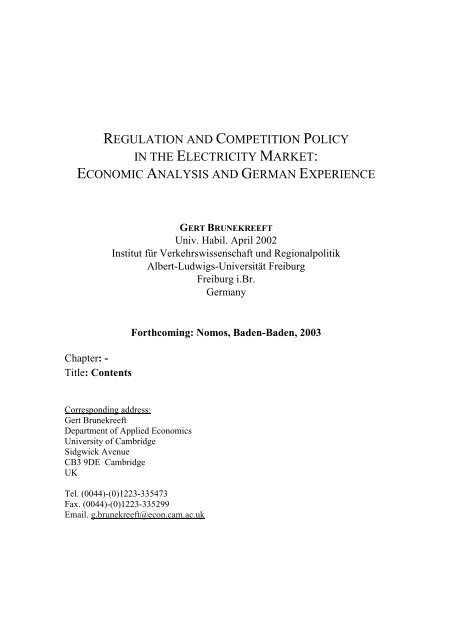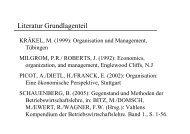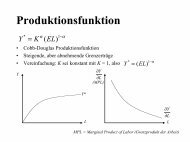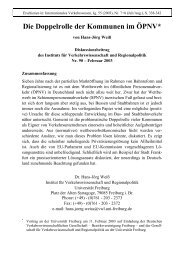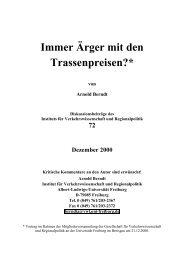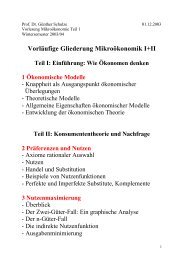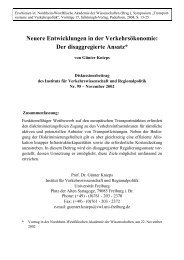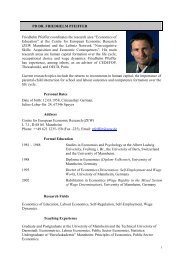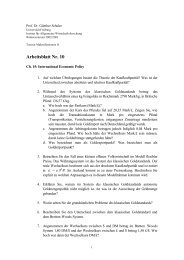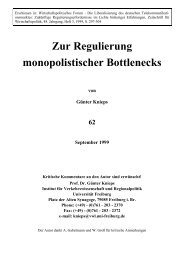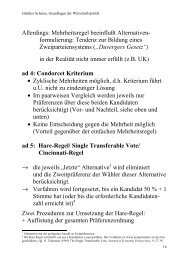regulation and competition policy in the electricity market: economic ...
regulation and competition policy in the electricity market: economic ...
regulation and competition policy in the electricity market: economic ...
Create successful ePaper yourself
Turn your PDF publications into a flip-book with our unique Google optimized e-Paper software.
REGULATION AND COMPETITION POLICY<br />
IN THE ELECTRICITY MARKET:<br />
ECONOMIC ANALYSIS AND GERMAN EXPERIENCE<br />
GERT BRUNEKREEFT<br />
Univ. Habil. April 2002<br />
Institut für Verkehrswissenschaft und Regionalpolitik<br />
Albert-Ludwigs-Universität Freiburg<br />
Freiburg i.Br.<br />
Germany<br />
Chapter:-<br />
Title: Contents<br />
Forthcom<strong>in</strong>g: Nomos, Baden-Baden, 2003<br />
Correspond<strong>in</strong>g address:<br />
Gert Brunekreeft<br />
Department of Applied Economics<br />
University of Cambridge<br />
Sidgwick Avenue<br />
CB3 9DE Cambridge<br />
UK<br />
Tel. (0044)-(0)1223-335473<br />
Fax. (0044)-(0)1223-335299<br />
Email. g.brunekreeft@econ.cam.ac.uk
CONTENTS<br />
ACKNOWLEDGEMENTS 5<br />
CONTENTS 7<br />
LIST OF ABBREVIATIONS 11<br />
1 INTRODUCTION AND PRELIMINARIES 13<br />
1.1 THE PROBLEM OF THE ELECTRICITY SUPPLY INDUSTRY IN GERMANY 13<br />
1.2 VERTICAL STRUCTURE AND NON-DISCRIMINATORY THIRD-PARTY ACCESS 16<br />
1.2.1 De<strong>regulation</strong>, restructur<strong>in</strong>g <strong>and</strong> privatisation 17<br />
1.2.2 Vertically disaggregated network <strong>in</strong>dustries 20<br />
1.3 REGULATORY INTERVENTIONS 23<br />
1.3.1 M<strong>in</strong>imal <strong>and</strong> disaggregated <strong>regulation</strong> 23<br />
1.3.2 Issues on regulatory <strong>in</strong>stitutions 25<br />
1.4 OUTLINE OF THE BOOK 27<br />
2 THE ELECTRICITY SUPPLY INDUSTRY 29<br />
2.1 INTRODUCTION 29<br />
2.2 VERTICAL STAGES IN THE ESI 30<br />
2.2.1 Generation 30<br />
2.2.2 Transmission 32<br />
2.2.3 Distribution 32<br />
2.2.4 Retail 33<br />
2.3 THE INSTITUTIONAL APPROACH 34<br />
2.3.1 Free entry <strong>and</strong> end-user eligibility 35<br />
2.3.2 The approach to <strong>the</strong> vertical <strong>in</strong>dustry structure 36<br />
2.3.3 Third-party access <strong>and</strong> <strong>regulation</strong> of <strong>the</strong> access charges 39<br />
2.3.4 The basics of o<strong>the</strong>r issues 43<br />
2.4 CONCLUDING REMARKS 47<br />
3 THIRD-PARTY DISCRIMINATION IN POWER MARKETS 49<br />
3.1 INTRODUCTION 49<br />
3.2 ASPECTS OF AN ELECTRICAL SYSTEM 50<br />
3.3 CORE ISSUES 52<br />
3.3.1 Imbalances 52<br />
3.3.2 Load profiles 55<br />
3.3.3 Quality-of-supply 58<br />
3.4 FRINGE ISSUES 60<br />
3.4.1 Refusal to provide TPA 60<br />
3.4.2 Switch<strong>in</strong>g costs 63<br />
3.5 CONCLUDING REMARKS 66<br />
7
4 PRICE-CAP REGULATION 69<br />
4.1 INTRODUCTION 69<br />
4.2 PRICE CAPPING: THE TARIFF BASKET VERSUS THE AVERAGE REVENUE CAP 72<br />
4.3 STRIKING A BALANCE: THE VALUE OF X 79<br />
4.3.1 Sett<strong>in</strong>g X 79<br />
4.3.2 Determ<strong>in</strong><strong>in</strong>g X 81<br />
4.4 A SELECTION OF OTHER ISSUES 82<br />
4.4.1 Price structure 83<br />
4.4.2 Investment, quality-of-supply <strong>and</strong> <strong>in</strong>novation 86<br />
4.5 CONCLUDING REMARKS 87<br />
5 THIRD-PARTY DISCRIMINATION AND THE REGULATION OF THE<br />
ACCESS CHARGES: THE INCENTIVES 89<br />
5.1 INTRODUCTION 89<br />
5.2 THE LITERATURE 89<br />
5.2.1 The Chicago-benchmark 89<br />
5.2.2 Relative efficiency 90<br />
5.2.3 Imperfect <strong>competition</strong> 92<br />
5.2.4 Price discrim<strong>in</strong>ation 93<br />
5.2.5 Regulation of <strong>the</strong> access charge 94<br />
5.3 THE SETTING 96<br />
5.4 RESULTS 100<br />
5.5 THE SWITCHING LEVEL 104<br />
5.6 CONCLUDING REMARKS 106<br />
5.7 APPENDIX 108<br />
6 REGULATION IN VERTICALLY RELATED MARKETS 111<br />
6.1 INTRODUCTION 111<br />
6.2 SOCIAL-WELFARE MAXIMISATION 112<br />
6.2.1 The disaggregated approach - regulat<strong>in</strong>g r <strong>and</strong> z 112<br />
6.2.2 Reflections on <strong>the</strong> exceptional case of z > 0: "<strong>in</strong>efficient entry" 117<br />
6.2.3 Some fur<strong>the</strong>r remarks on <strong>the</strong> global price cap 119<br />
6.3 THE STIGLER-PELTZMAN APPROACH 121<br />
6.4 CONCLUDING REMARKS 125<br />
7 THE UNITED KINGDOM: DESIGNING THE STRUCTURE 127<br />
7.1 INTRODUCTION 127<br />
7.2 THE SECTOR 128<br />
7.2.1 Generation 128<br />
7.2.2 Distribution <strong>and</strong> retail 129<br />
7.2.3 Trad<strong>in</strong>g: The Pool 130<br />
7.2.4 Regulation 133<br />
7.3 STRUCTURAL INTERVENTION AND COMPETITIVENESS 135<br />
7.3.1 Developments 135<br />
8
7.3.2 The <strong>market</strong> abuse licence condition (MALC) 137<br />
7.3.3 From Pool to NETA 140<br />
7.3.4 Vertical separation of retail <strong>and</strong> distribution 143<br />
7.4 CONCLUDING REMARKS 145<br />
8 THE NETHERLANDS: PRICE-CAP REGULATION 147<br />
8.1 INTRODUCTION 147<br />
8.2 THE SECTOR 148<br />
8.3 THE LEGISLATIVE FRAME 150<br />
8.3.1 Historical overview 150<br />
8.3.2 The Electricity Act 1998 152<br />
8.3.3 Price caps: The consultation documents 154<br />
8.4 PRICE-CAP REGULATION 157<br />
8.4.1 Data Envelopment Analysis (DEA) 157<br />
8.4.2 The distribution networks 159<br />
8.4.3 The transmission network - TenneT 161<br />
8.4.4 Retail charges for captive customers 164<br />
8.5 CONCLUDING REMARKS 166<br />
9 REGULATORY THREAT IN VERTICALLY RELATED MARKETS 169<br />
9.1 INTRODUCTION 169<br />
9.2 PRELIMINARIES 171<br />
9.2.1 The <strong>in</strong>centives to use r <strong>and</strong> z <strong>in</strong> <strong>the</strong> unregulated case 172<br />
9.2.2 The legislator's decision 173<br />
9.3 REGULATORY THREAT 175<br />
9.3.1 The global threat 176<br />
9.3.2 The free-rider problem 178<br />
9.3.3 Regulatory threat can <strong>in</strong>duce <strong>the</strong> <strong>in</strong>centives to discrim<strong>in</strong>ate 180<br />
9.4 CONCLUDING REMARKS 182<br />
9.5 APPENDIX: THE SECOND-ORDER CONDITIONS 183<br />
10 REGULATORY THREAT IN NEW ZEALAND 185<br />
10.1 INTRODUCTION 185<br />
10.2 THE SECTOR 186<br />
10.3 THE LEGISLATIVE FRAME 188<br />
10.3.1 Light-h<strong>and</strong>ed <strong>regulation</strong> <strong>and</strong> <strong>the</strong> Commerce Act 1986 188<br />
10.3.2 Developments of <strong>the</strong> Electricity Act 191<br />
10.4 REGULATORY THREAT 195<br />
10.4.1 Developments 195<br />
10.4.2 Threat of price control <strong>in</strong> <strong>the</strong> Electricity Industry Reform Act 1998 197<br />
10.4.3 Fur<strong>the</strong>r <strong>in</strong>crease of <strong>the</strong> threat of price control 201<br />
10.5 CONCLUDING REMARKS 203<br />
9
11 NEGOTIATED THIRD-PARTY ACCESS IN GERMANY 205<br />
11.1 INTRODUCTION 205<br />
11.2 THE SECTOR 206<br />
11.3 NEGOTIATED THIRD-PARTY ACCES 211<br />
11.3.1 The <strong>in</strong>stitutional frame 211<br />
11.3.2 The Association Agreements for network access 214<br />
11.4 DEVELOPMENTS: ANALYSIS AND ASSESSMENT 218<br />
11.4.1 End-user prices 218<br />
11.4.2 Network-access charges 222<br />
11.4.3 Third-party discrim<strong>in</strong>ation 225<br />
11.5 CONCLUDING REMARK 228<br />
12 SUMMARY, CONCLUSIONS AND OUTLOOK 231<br />
12.1 SUMMARY AND MAIN CONCLUSIONS 231<br />
12.2 GERMAN EXPERIENCE 237<br />
12.3 COMPETITION LAW OR SECTOR-SPECIFIC REGULATION 241<br />
12.4 OUTLOOK 244<br />
REFERENCES 247<br />
INDEX 257<br />
10


